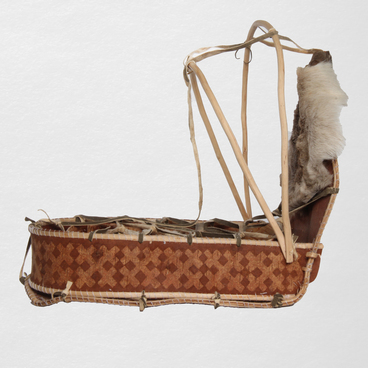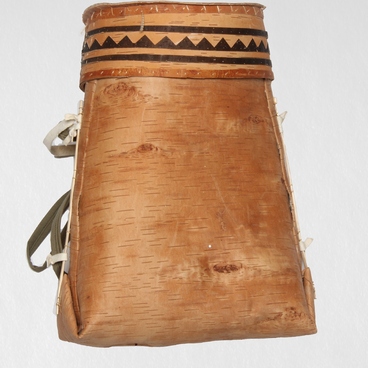The tree and all its parts play an important role in the life of the indigenous peoples of the North. The Khanty use everything that it can give in everyday life: the wood itself, bark, branches and even roots. Most of the items, from miniature saltshakers to oversized backpack boxes, are made from birch bark, the top layer of bark of birch trees.
Many materials from which northern peoples make utensils, not only have important physical properties: strength and thermal conductivity, but are also considered sacred. For example, the valuable Siberian cedar pine, according to Khanty legends, is of divine origin.
Wood household utensils are less varied. Usually bailers, troughs and backets, mortars, tubs, flat dugout dishes and plates, as well as cups, from which the Khanty drink meat broth and fish soup, are made out of wood.
Khanty dishes are most often cut from burl wood — a rounded growth on a tree trunk, in which the directions of fiber growth are deformed. Thanks to its complex texture, burl wood is very beautiful, and the patterns of one cup will never be repeated in another. The burls are almost always covered with bark, so their wood is not infected with fungus or destroyed by insects.
The Khanty cut large items from large and long pieces of wood. The most commonly used are pine, birch, larch and aspen wood.
A wooden box, or “kut”, from the collection of the Muravlenko museum is intended for storing women’s handicrafts. In such boxes, housewives keep scraps of deerskins, beads, tendon threads and various accessories for sewing clothes.
The box has a traditional rectangular shape with rounded corners and consists of two parts — a box and a wooden lid. All of its parts are made of solid pine planks. In order to shape the wood in the desired way, it is treated with steam and slowly bent, making sure that it does not crack. Then the ends of the bent wood are fastened with strips of deer hide and strong tendons.
The outside of the box is painted brown. The box is quite deep, and at its bottom there is a brown skin with long fur. The box lid fits tightly; short brown fur is also attached on top of the lid.
Many materials from which northern peoples make utensils, not only have important physical properties: strength and thermal conductivity, but are also considered sacred. For example, the valuable Siberian cedar pine, according to Khanty legends, is of divine origin.
Wood household utensils are less varied. Usually bailers, troughs and backets, mortars, tubs, flat dugout dishes and plates, as well as cups, from which the Khanty drink meat broth and fish soup, are made out of wood.
Khanty dishes are most often cut from burl wood — a rounded growth on a tree trunk, in which the directions of fiber growth are deformed. Thanks to its complex texture, burl wood is very beautiful, and the patterns of one cup will never be repeated in another. The burls are almost always covered with bark, so their wood is not infected with fungus or destroyed by insects.
The Khanty cut large items from large and long pieces of wood. The most commonly used are pine, birch, larch and aspen wood.
A wooden box, or “kut”, from the collection of the Muravlenko museum is intended for storing women’s handicrafts. In such boxes, housewives keep scraps of deerskins, beads, tendon threads and various accessories for sewing clothes.
The box has a traditional rectangular shape with rounded corners and consists of two parts — a box and a wooden lid. All of its parts are made of solid pine planks. In order to shape the wood in the desired way, it is treated with steam and slowly bent, making sure that it does not crack. Then the ends of the bent wood are fastened with strips of deer hide and strong tendons.
The outside of the box is painted brown. The box is quite deep, and at its bottom there is a brown skin with long fur. The box lid fits tightly; short brown fur is also attached on top of the lid.



